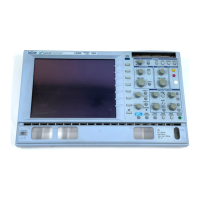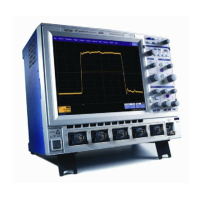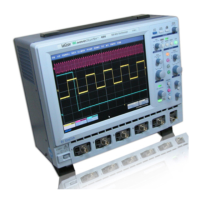410 WM-OM-E Rev I
acsn Auto-Correlation Signal-to-Noise
Definition Provides a signal-to-noise ratio for periodic waveforms.
Description Using the DDA’s correlation function, acsn provides a measurement of the
auto-correlation signal-to-noise for a repetitive waveform. At least two waveform
repetitions need to be acquired in order to calculate acsn. In addition, the period
of the waveform must be specified.
Selecting this parameter displays a hysteresis-dialog for setting the hysteresis
value to a specified number of vertical divisions.
The parameter then verifies, and may adjust, the period based on the value
provided. This is crucial because variations in disk rotation speed make the exact
length of time for a disk waveform difficult to determine.
Using the period as a starting point, the DDA performs an auto-correlation and
looks for an auto-correlation peak at the period. At the top of the peak, the pattern
repeats. The DDA locates the top and notes the corresponding time so that it can
determine the period. Then it recalculates the auto-correlation using this period.
The value of the auto-correlation at the period peak, R, is used to calculate the
ACSN as:
S/N = R/(1R),
ACSN = 10* log10 S/N.
For greater accuracy, the instrument averages several ACSN measurements
when calculating acsn. An ACSN measurement is performed for each pattern,
and the results averaged.
All individual ACSN measurements can be observed by histogramming the acsn
parameter. ACSN is limited to measuring signal-to-noise ratios of 9.6 dB or
greater.
ACSN results are presented in dB. All averaging, including statistics and trend
average, is performed on linear units. Averaged results are then converted to dB.
